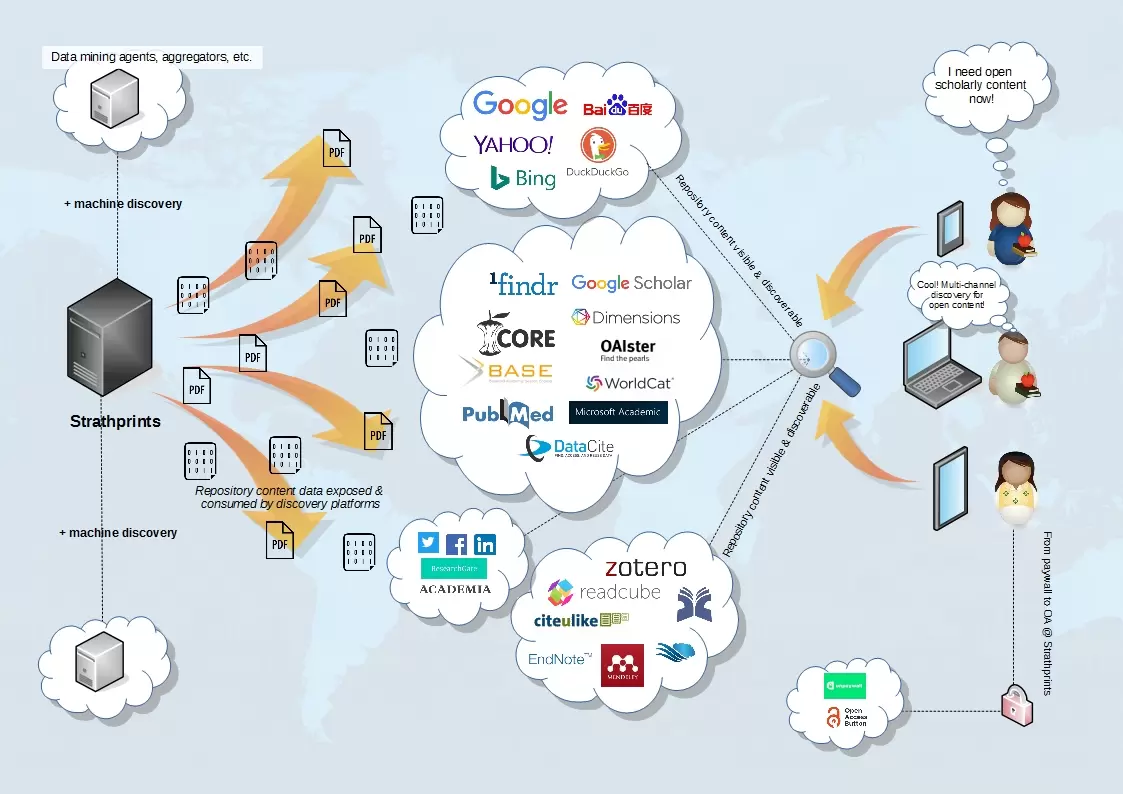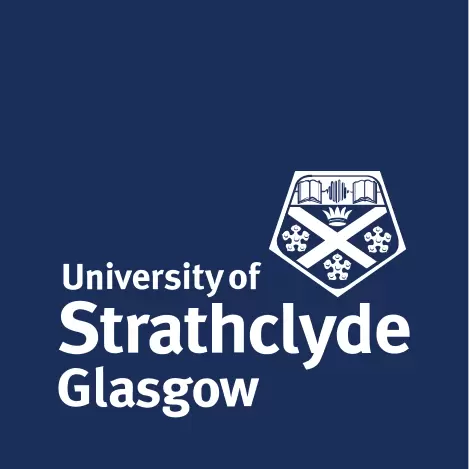About Strathprints
What is Strathprints?
Improving the visibility and impact of Strathclyde research: how does Strathprints do it?
How do I deposit my research outputs in Strathprints? What is PURE?
How long does it take to deposit (and 'validate') my research outputs?
What is the "EPrints request button" and why have I received an email from Strathprints requesting I send a manuscript to a user?
What software does Strathprints use?
What policies does Strathprints have relating to metadata, content, etc.?
Where can I learn more about copyright in relation to Strathprints? Where is the Strathprints "notice and take down policy"?
Does Strathprints have information about any cookies it uses and, if so, what for - and any personal data collected?
I like the banner images you have used in Strathprints. Where did you source them?
Where can I access Strathclyde's Open Access theses? How do I deposit a thesis?
What is the Strathprints Licence- Version 1.0?
What is Strathprints?
The Strathprints institutional repository is a digital archive of University of Strathclyde research outputs. It has been developed to disseminate Open Access research outputs, expose data about those outputs, and enable the management and persistent access to Strathclyde's intellectual output. The management of Strathprints is performed by the Scholarly Publications & Research Data team based within the Information Services Directorate (Library).
Repositories like Strathprints are an important instrument of Open Access and alternative approaches to scholarly communication because they make research papers and other scholarly outputs freely available on the Internet, thereby maximising their visibility and potential impact. The benefits of Open Access are such that governments and most research funders now have policies for making research outputs openly available. Our Open Access @ Strathclyde pages explain more about this and the different approaches to making scholarly work openly accessible.
Improving the visibility and impact of Strathclyde research: how does Strathprints do it?
One of the unique features of institutional repositories is that they support a wide variety of technical protocols that enable discovery tools, from generic academic search tools such as Google Scholar to more specialist tools such as CORE or BASE , DS Dimensions , or Lens.org, to interoperate with Strathprints. This allows these discovery tools to learn about the research outputs Strathprints contains in a way these systems prefer, but also enables these systems to direct their users to the research which Strathprints holds. Tools like CORE, an important component of scholarly open infrastructure, can harvest and aggregate content from Strathprints, thereby enabling exciting text and data mining (TDM) functionality, capable of unlocking new scientific discoveries.
Systems like Strathprints are also central to new in-browser Open Access tools such as Unpaywall, CORE Discovery and the Open Access Button, allowing users to discover openly available research papers whenever they encounter a paywall.
The diagram below illustrates some of the many systems Strathprints exposes data to and interoperates with, which in addition to those already mentioned, also includes 'LinkOut' with PubMed Central, discovery via all the major web search engines and academic search engines (e.g. Microsoft Academic Search and Google Scholar) and WorldCat.

How do I deposit my research outputs in Strathprints?
All research active staff based at the University of Strathclyde can deposit their research outputs in Strathprints via PURE. PURE (DS account required) is the University's current research information system and is used to capture the research activities of the University, consolidating it with data from corporate systems, in order to provide users with a single source of information.
Research outputs uploaded to PURE will progress through a process of 'validation' before being approved, after which they will be automatically deposited in Strathprints. Note that the process of validation, among many other things, seeks to ensure outputs deposited in Strathprints do not infringe copyright.
Further information on the PURE validation process is available from the Open Access @ Strathclyde pages, with guidance documentation available from the Development and Training Gateway (DS account required).
How long does it take to deposit (and 'validate') my research outputs?
Research outputs must undergo a process of validation before they can be deposited in Strathprints. The Scholarly Publications & Research Data teams is responsible for validating hundreds of items and depositing hundreds of files per week. The process of validation is largely undertaken on PURE and can be time consuming, entailing Open Access compliance checks, file handling tasks (e.g. to improve accessibility, digital preservation ingest, etc.), publisher policy checks, metadata creation, and many more. Some form of prioritisation is therefore required based on the type of content submitted for validation.
Current Standards
- We will respond to email enquiries received via openaccess@strath.ac.uk within 3 working days
- We will validate prioritised REF outputs within 7 working days
Please ensure that when updated publication profiles are required for promotion panels, that notice of at least two weeks is provided. Please contact openaccess@strath.ac.uk in advance if you have a considerable number of publications to submit.
Where a large number of items are submitted for validation with no prior communication, a Fresh Service ticket may be raised to monitor progress. An estimate on the time to validate such records will only be possible with reference to the existing workload at this time and the nature of the deposited items.
To minimise the amount of record editing and corrections required, please consult the published guidance carefully before depositing, editing or deleting records in Pure.
What is the "EPrints request button" and why have I received an email from Strathprints requesting I send a manuscript to a user?
The "Request eprint" link is a feature of Strathprints and is displayed on the abstract page of research outputs. The link is displayed to users when a record about a research output contains:
- one or more restricted documents (e.g. one or more of the outputs is under a temporary embargo), or;
- no documents (e.g. the Strathclyde author has failed to deposit a research output).
By clicking the "Request eprint" link, users can submit a request to Strathprints which, in turn, generates an email to the author (or other recipient determined by EPrints) requesting a copy of the restricted/missing items.
The "Request eprint" link therefore facilitates so-called Almost Open Access. Strathclyde authors are encouraged to respond positively to such manuscript requests since they are a key mechanism of providing legitimate and legal access to research outputs that are not Open Access or might otherwise be inaccessible.
What software does Strathprints use?
Strathprints is powered by EPrints 3.4.2, free repository software developed by the University of Southampton, employing MariaDB, Apache Webserver, Red Hat Enterprise Linux, Perl, mod_perl, Digital Object Model (DOM), Resource Description Framework (RDF) and XML. EPrints supports the Open Archives Initiative Protocol for Metadata Harvesting (OAI-PMH), Linked Data, Semantic Sitemap Extension [PDF doc], and many more...
What policies does Strathprints have relating to metadata, content, etc.?
Strathprints has a number of policies governing the use and re-use of metadata, data, and content as well as policies for digital preservation and the deposit of content. Details of these policies are available from our Strathprints policies page. For policies governing Research Data Management please consult the RDMS pages.
Where can I learn more about copyright in relation to Strathprints? Where is the Strathprints "notice and take down policy"?
Some guidance on copyright is available within Strathprints; but more detailed information and assistance is available from Information Governance and Compliance.
Every effort has been made to ensure that no deposited content infringes any third party property rights or otherwise infringes applicable laws. Strathprints operates a notice and take down policy should you discover any content that you consider to infringe your rights.
Does Strathprints have information about any cookies it uses and, if so, what for - and any personal data collected?
Cookies are small text files that are placed on your computer by websites that you visit. They are used widely across the web to make websites work more effectively, as well as to provide information to the owners of websites. Users placing EPrint requests (e.g. for embargoed content) should note that minimal personal data are collected and some cookies are used to assist in the operation of Strathprints. Further information about the nature of these cookies, how they are used, and personal data collected is available from our cookie & privacy information page.
I like the banner images you have used in Strathprints. Where can I find them?
In the spirit of Open Access, all the banner images Strathprints uses are openly available via a number image repositories, either under a CC-BY (attribution) or CC-0 (public domain) licence. Tools used included Wikimedia Commons, Europeana, Unsplash and Pixabay.
Where can I access Strathclyde's Open Access theses? How do I deposit a thesis?
Good question! Although you may find some digital theses within Strathprints, the true home of Strathclyde theses is actually STAX. STAX is a separate Strathclyde repository service for storing and sharing digital theses but also some other forms of grey literature. STAX enjoys similar levels of visibility and exposure as Strathprints and ensures theses are appropriately managed over time. Note that the process for depositing theses is different since both thesis submission and deposit are connected to successful completion of postgraduate qualifications. Further information on the University of Strathclyde thesis submission process is available from the main University website.
What is the Strathprints Licence- Version 1.0?
The Strathprints digital repository is designed to allow users to access the research output of the University of Strathclyde. Copyright © and Moral Rights of this research publication are retained by the individual author(s) and/or other copyright owner(s).
- You may freely distribute both the item URL and the content of this publication for research or study, educational, or not-for-profit purposes without prior permission or charge.
- You may not engage in further distribution of the research publication for any profitmaking activities or any commercial gain.
- Full bibliographic details including the author(s), title, and date of the work must be given in all references to this research publication.
Notice and Takedown statement for publications deposited in Strathprints
If the Strathprints administrator Strathprints Administrator is notified of a potential breach of copyright concerning a publication, or receives a complaint indicating a violation of publishers' rules or other relevant concern, the digital item involved will be removed as quickly as possible pending further investigation. Where the grounds for complaint are considered plausible, the digital item will be permanently removed.
Enquiries about this licence and copyright statement can be directed to the Strathprints administrator Strathprints Administrator

